check engine KIA CADENZA 2011 Workshop Manual
[x] Cancel search | Manufacturer: KIA, Model Year: 2011, Model line: CADENZA, Model: KIA CADENZA 2011Pages: 352, PDF Size: 28.17 MB
Page 297 of 352
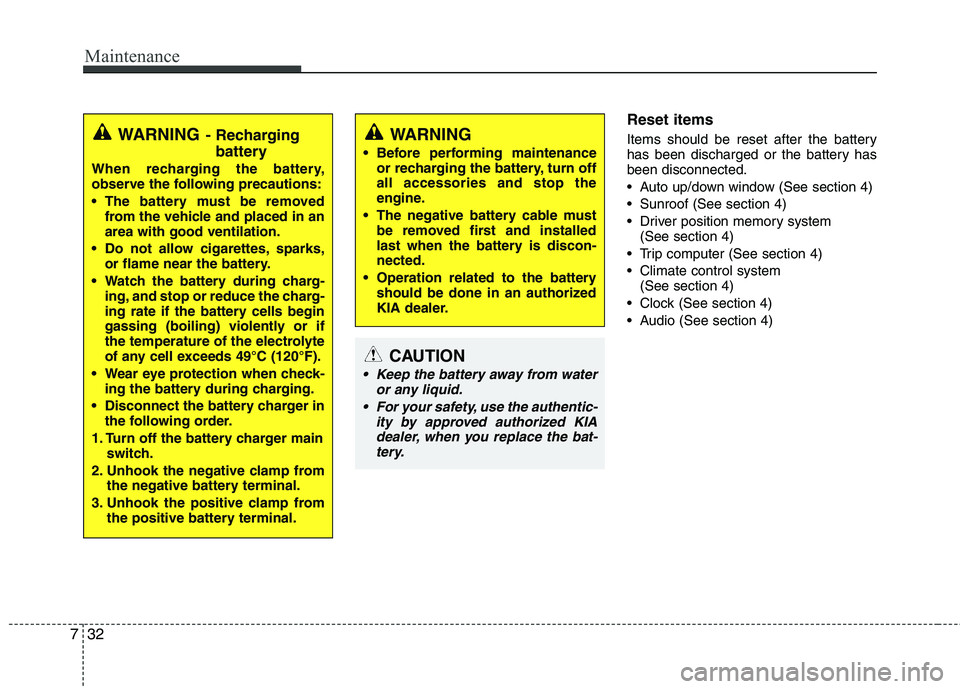
Maintenance
32
7
Reset items
Items should be reset after the battery
has been discharged or the battery hasbeen disconnected.
Auto up/down window (See section 4)
Sunroof (See section 4)
Driver position memory system
(See section 4)
Trip computer (See section 4)
Climate control system (See section 4)
Clock (See section 4)
Audio (See section 4)
WARNING
Before performing maintenance or recharging the battery, turn off all accessories and stop the
engine.
The negative battery cable must be removed first and installed
last when the battery is discon-nected.
Operation related to the battery should be done in an authorized
KIA dealer.
CAUTION
Keep the battery away from water
or any liquid.
For your safety, use the authentic- ity by approved authorized KIAdealer, when you replace the bat-tery.
WARNING - Recharging
battery
When recharging the battery,
observe the following precautions:
The battery must be removed from the vehicle and placed in an area with good ventilation.
Do not allow cigarettes, sparks, or flame near the battery.
Watch the battery during charg- ing, and stop or reduce the charg-
ing rate if the battery cells begin
gassing (boiling) violently or if
the temperature of the electrolyte
of any cell exceeds 49°C (120°F).
Wear eye protection when check- ing the battery during charging.
Disconnect the battery charger in the following order.
1. Turn off the battery charger main switch.
2. Unhook the negative clamp from the negative battery terminal.
3. Unhook the positive clamp from the positive battery terminal.
Page 308 of 352
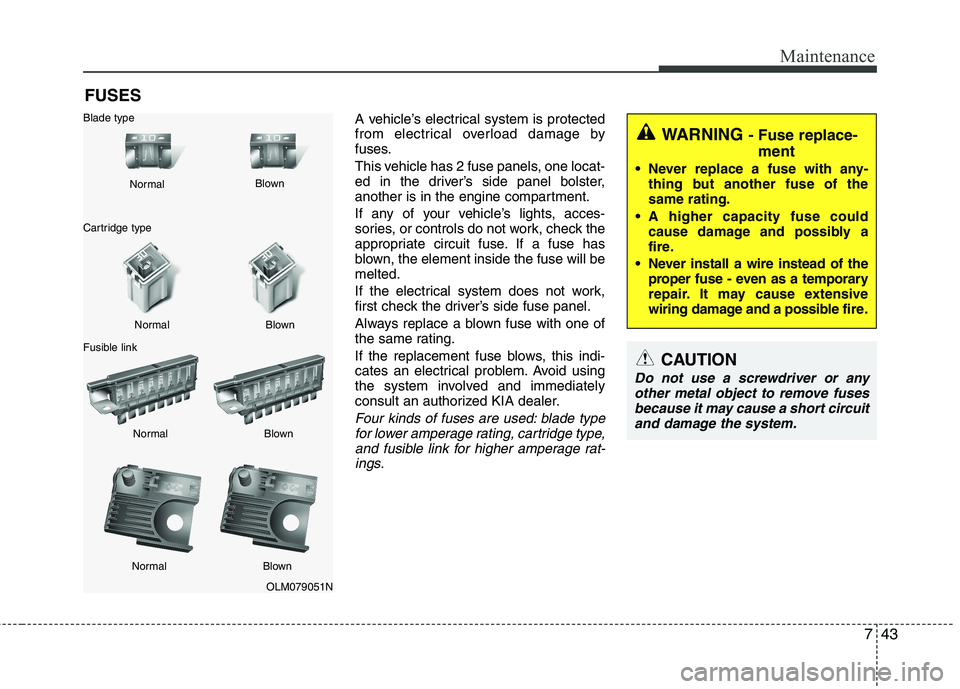
743
Maintenance
FUSESA vehicle’s electrical system is protected
from electrical overload damage by
fuses.
This vehicle has 2 fuse panels, one locat-
ed in the driver’s side panel bolster,
another is in the engine compartment.
If any of your vehicle’s lights, acces-
sories, or controls do not work, check the
appropriate circuit fuse. If a fuse has
blown, the element inside the fuse will bemelted.
If the electrical system does not work,
first check the driver’s side fuse panel.
Always replace a blown fuse with one of
the same rating.
If the replacement fuse blows, this indi-
cates an electrical problem. Avoid using
the system involved and immediately
consult an authorized KIA dealer.
Four kinds of fuses are used: blade typefor lower amperage rating, cartridge type, and fusible link for higher amperage rat-ings.
WARNING - Fuse replace-
ment
Never replace a fuse with any- thing but another fuse of the same rating.
A higher capacity fuse could cause damage and possibly a
fire.
Never install a wire instead of the proper fuse - even as a temporary
repair. It may cause extensive
wiring damage and a possible fire.
CAUTION
Do not use a screwdriver or any
other metal object to remove fuses because it may cause a short circuitand damage the system.
OLM079051N
Normal
Normal
Blade type
Cartridge type
Fusible link Blown
Blown
Normal Blown
Normal Blown
Page 309 of 352
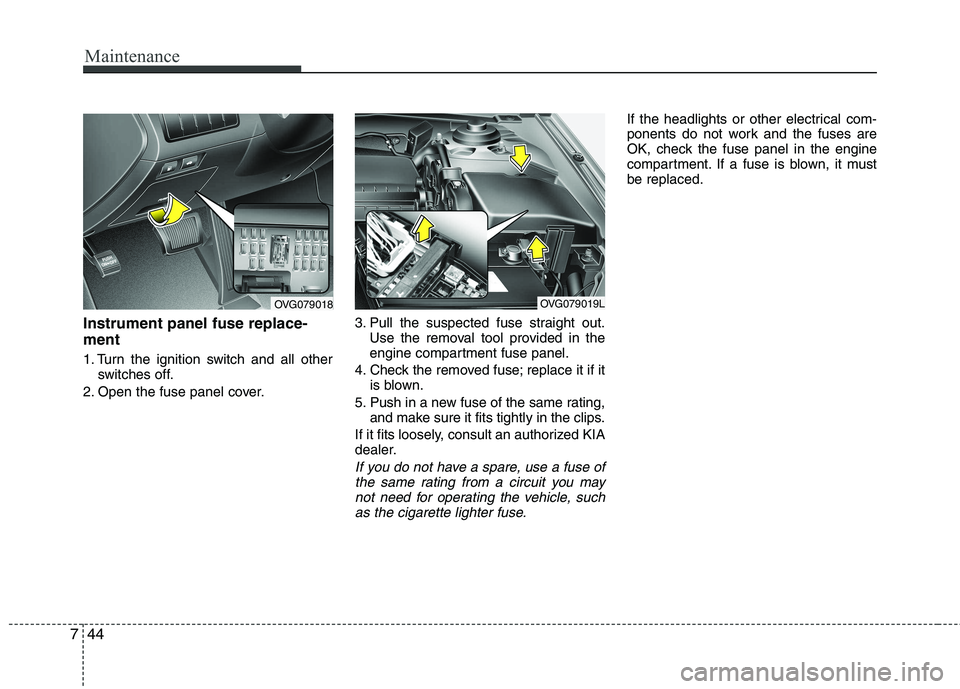
Maintenance
44
7
Instrument panel fuse replace- ment
1. Turn the ignition switch and all other
switches off.
2. Open the fuse panel cover. 3. Pull the suspected fuse straight out.
Use the removal tool provided in the
engine compartment fuse panel.
4. Check the removed fuse; replace it if it is blown.
5. Push in a new fuse of the same rating, and make sure it fits tightly in the clips.
If it fits loosely, consult an authorized KIA
dealer.
If you do not have a spare, use a fuse of the same rating from a circuit you may
not need for operating the vehicle, such as the cigarette lighter fuse.
If the headlights or other electrical com-
ponents do not work and the fuses are
OK, check the fuse panel in the engine
compartment. If a fuse is blown, it mustbe replaced.
OVG079018OVG079019L
Page 310 of 352
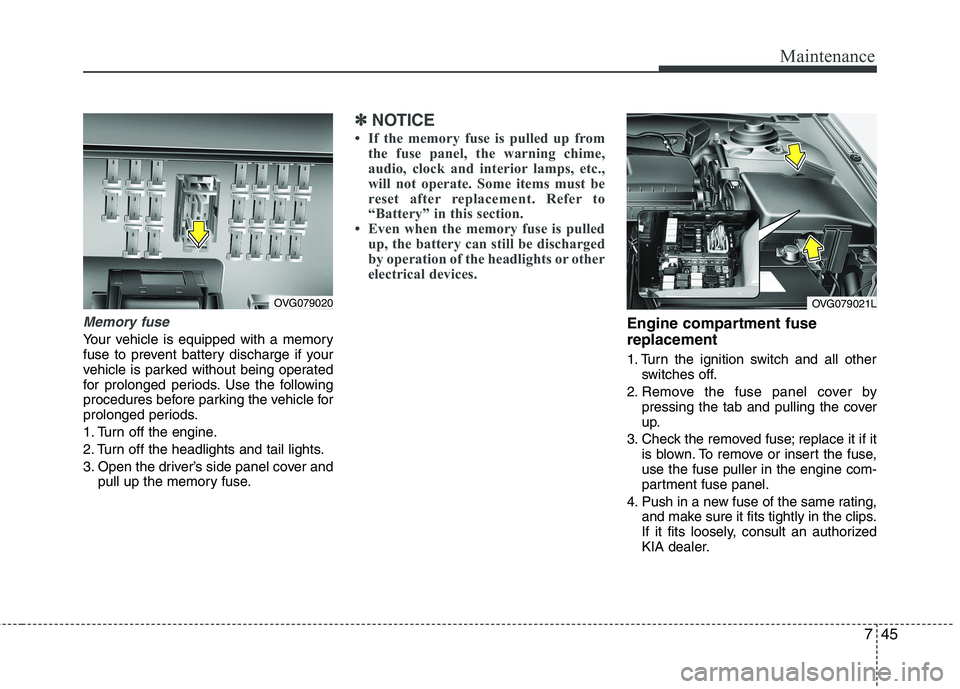
745
Maintenance
Memory fuse
Your vehicle is equipped with a memory
fuse to prevent battery discharge if your
vehicle is parked without being operated
for prolonged periods. Use the following
procedures before parking the vehicle for
prolonged periods.
1. Turn off the engine.
2. Turn off the headlights and tail lights.
3. Open the driver’s side panel cover andpull up the memory fuse.
✽✽ NOTICE
If the memory fuse is pulled up from the fuse panel, the warning chime,
audio, clock and interior lamps, etc.,
will not operate. Some items must be
reset after replacement. Refer to
“Battery” in this section.
Even when the memory fuse is pulled
up, the battery can still be discharged
by operation of the headlights or other
electrical devices.
Engine compartment fuse replacement
1. Turn the ignition switch and all other switches off.
2. Remove the fuse panel cover by pressing the tab and pulling the cover
up.
3. Check the removed fuse; replace it if it is blown. To remove or insert the fuse,use the fuse puller in the engine com-
partment fuse panel.
4. Push in a new fuse of the same rating, and make sure it fits tightly in the clips.
If it fits loosely, consult an authorized
KIA dealer.
OVG079020OVG079021L
Page 311 of 352
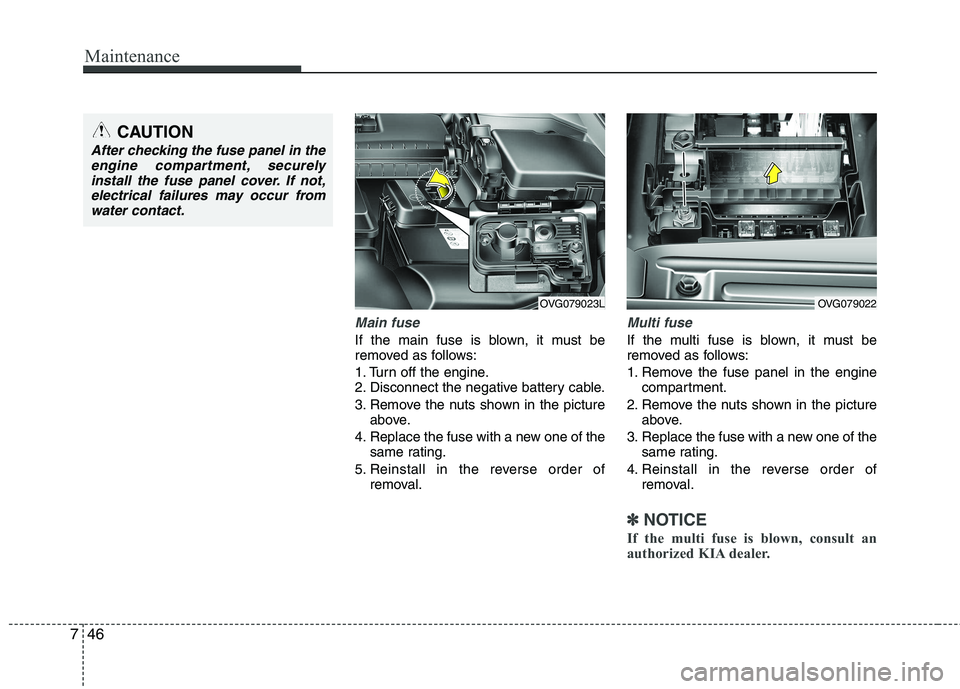
Maintenance
46
7
Main fuse
If the main fuse is blown, it must be
removed as follows:
1. Turn off the engine.
2. Disconnect the negative battery cable.
3. Remove the nuts shown in the picture
above.
4. Replace the fuse with a new one of the same rating.
5. Reinstall in the reverse order of removal.
Multi fuse
If the multi fuse is blown, it must be
removed as follows:
1. Remove the fuse panel in the enginecompartment.
2. Remove the nuts shown in the picture above.
3. Replace the fuse with a new one of the same rating.
4. Reinstall in the reverse order of removal.
✽✽ NOTICE
If the multi fuse is blown, consult an
authorized KIA dealer.
CAUTION
After checking the fuse panel in the engine compartment, securely
install the fuse panel cover. If not,electrical failures may occur fromwater contact.
OVG079023LOVG079022
Page 317 of 352

Maintenance
52
7
DescriptionSymbolFuse ratingProtected component
MULTI
FUSE
B+260AIPM (Fuse - F7/ F8/ F9/ F19, IPS Control - IPS1/ IPS2/ IPS3/ IPS5/ IPS7)
B+360AIPM (Fuse - F17/ F24/ F25/ F26/ F33/ F34)
IGN140A[W/O Smart Key] Ignition Switch, [With Smart Key] RLY. 1 (ACC Relay), RLY. 9 (IG1 Relay)
40AESP Control Module, ABS Control Module
RR HTD40ARLY. 2 (Rear Defogger Relay)
40ARLY. 14 (Blower Relay)
B+460AIPM (Fuse- F2/ F10, IPS Control - IPS 0/ IPS4/ TURN/ IPS6)
SPARE80A-
FUSE
10AA/C Control Module
B/UP LP10ARLY. 8 (Back-up Lamp Relay), Stop Lamp Switch, Multipurpose Check Connector
IGN10ARLY. 6 (Start2 Relay), Alternator (G6DC)
110APCM, Transaxle Range Switch
Engine compartment main fuse panel
Page 335 of 352
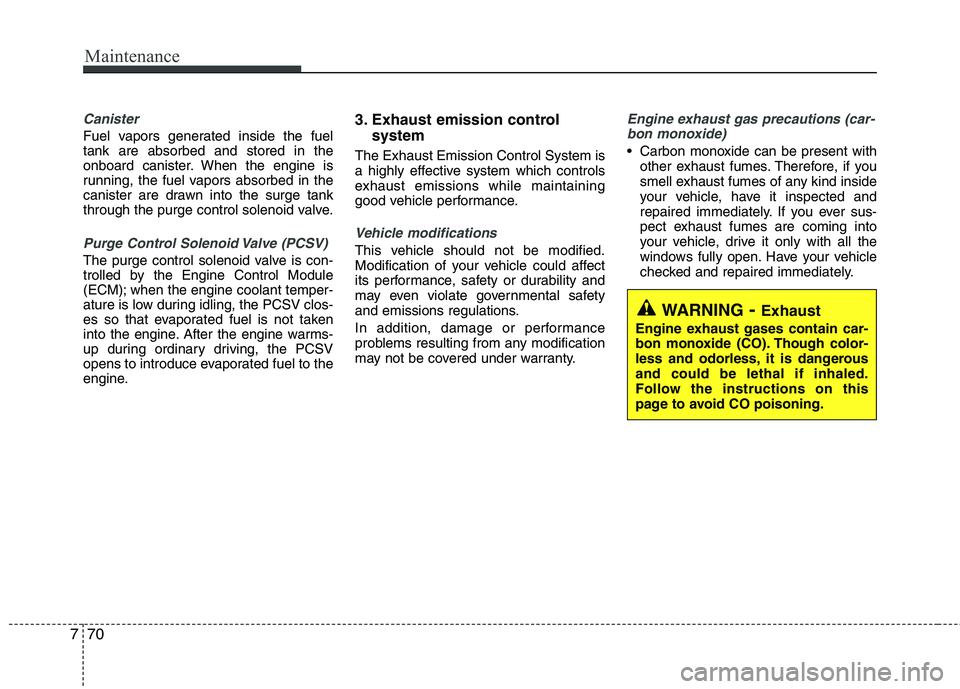
Maintenance
70
7
Canister
Fuel vapors generated inside the fuel tank are absorbed and stored in the
onboard canister. When the engine is
running, the fuel vapors absorbed in the
canister are drawn into the surge tank
through the purge control solenoid valve.
Purge Control Solenoid Valve (PCSV)
The purge control solenoid valve is con-
trolled by the Engine Control Module
(ECM); when the engine coolant temper-
ature is low during idling, the PCSV clos-
es so that evaporated fuel is not taken
into the engine. After the engine warms-
up during ordinary driving, the PCSV
opens to introduce evaporated fuel to the
engine. 3. Exhaust emission control
system
The Exhaust Emission Control System is
a highly effective system which controls
exhaust emissions while maintaining
good vehicle performance.
Vehicle modifications
This vehicle should not be modified.
Modification of your vehicle could affect
its performance, safety or durability and
may even violate governmental safety
and emissions regulations.
In addition, damage or performance
problems resulting from any modification
may not be covered under warranty.
Engine exhaust gas precautions (car- bon monoxide)
Carbon monoxide can be present with other exhaust fumes. Therefore, if you
smell exhaust fumes of any kind inside
your vehicle, have it inspected and
repaired immediately. If you ever sus-
pect exhaust fumes are coming into
your vehicle, drive it only with all the
windows fully open. Have your vehicle
checked and repaired immediately.
WARNING - Exhaust
Engine exhaust gases contain car-
bon monoxide (CO). Though color-
less and odorless, it is dangerousand could be lethal if inhaled.
Follow the instructions on this
page to avoid CO poisoning.
Page 341 of 352
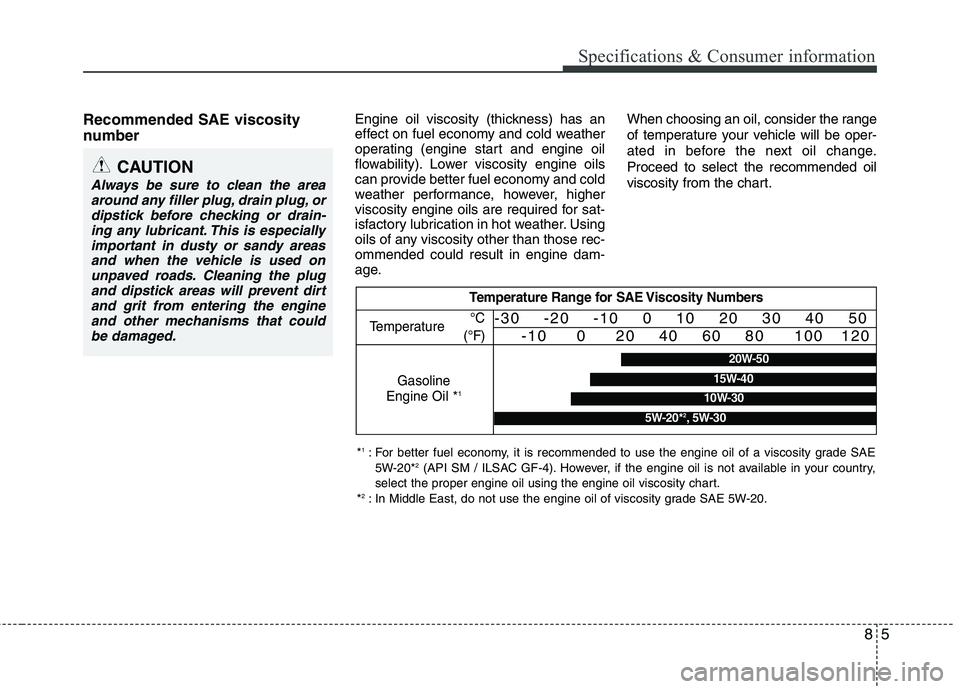
85
Specifications & Consumer information
Recommended SAE viscosity
number Engine oil viscosity (thickness) has an
effect on fuel economy and cold weather
operating (engine start and engine oil
flowability). Lower viscosity engine oils
can provide better fuel economy and cold
weather performance, however, higher
viscosity engine oils are required for sat-
isfactory lubrication in hot weather. Using
oils of any viscosity other than those rec-ommended could result in engine dam-
age.When choosing an oil, consider the range
of temperature your vehicle will be oper-
ated in before the next oil change.Proceed to select the recommended oil
viscosity from the chart.
CAUTION
Always be sure to clean the area
around any filler plug, drain plug, ordipstick before checking or drain-ing any lubricant. This is especially
important in dusty or sandy areasand when the vehicle is used onunpaved roads. Cleaning the plugand dipstick areas will prevent dirt
and grit from entering the engine and other mechanisms that couldbe damaged.
Temperature Range for SAE Viscosity Numbers
Temperature
Gasoline
Engine Oil * 1°C
(°F)-30 -20 -10 0 10 20 30 40 50 -10 0 20 40 60 80 100 120
*1
: For better fuel economy, it is recommended to use the engine oil of a viscosity grade SAE
5W-20* 2
(API SM / ILSAC GF-4). However, if the engine oil is not available in your country,
select the proper engine oil using the engine oil viscosity chart.
* 2
: In Middle East, do not use the engine oil of viscosity grade SAE 5W-20.
20W-50
10W-30
15W-40
5W-20* 2
, 5W-30
Page 346 of 352
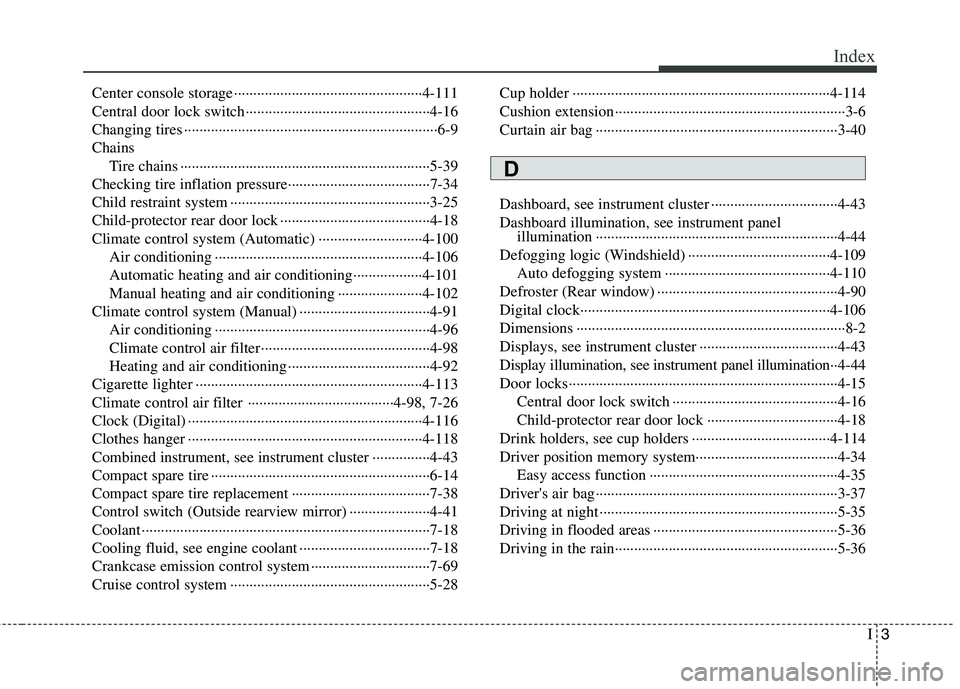
I3
Index
Center console storage ·················································4-111
Central door lock switch················································4-16
Changing tires ··································································6-9Chains
Tire chains ·································································5-39
Checking tire inflation pressure·····································7-34
Child restraint system ····················································3-25
Child-protector rear door lock ·······································4-18
Climate control system (Automatic) ···························4-100 Air conditioning ······················································4-106
Automatic heating and air conditioning··················4-101
Manual heating and air conditioning ······················4-102
Climate control system (Manual) ··································4-91
Air conditioning ························································4-96
Climate control air filter············································4-98
Heating and air conditioning ·····································4-92
Cigarette lighter ···························································4-113
Climate control air filter ······································4-98, 7-26
Clock (Digital) ·····························································4-116
Clothes hanger ·····························································4-118
Combined instrument, see instrument cluster ···············4-43
Compact spare tire ·························································6-14
Compact spare tire replacement ····································7-38
Control switch (Outside rearview mirror) ·····················4-41
Coolant ···········································································7-18
Cooling fluid, see engine coolant ··································7-18
Crankcase emission control system ·······························7-69
Cruise control system ····················································5-28 Cup holder ···································································4-114
Cushion extension ····························································3-6
Curtain air bag ·······························································3-40
Dashboard, see instrument cluster ·································4-43
Dashboard illumination, see instrument panel
illumination ·······························································4-44
Defogging logic (Windshield) ·····································4-109 Auto defogging system ···········································4-110
Defroster (Rear window) ···············································4-90
Digital clock·································································4-106
Dimensions ······································································8-2
Displays, see instrument cluster ····································4-43
Display illumination, see instrument panel illumination··4-44
Door locks······································································4-15 Central door lock switch ···········································4-16
Child-protector rear door lock ··································4-18
Drink holders, see cup holders ····································4-114
Driver position memory system·····································4-34 Easy access function ·················································4-35
Driver's air bag·······························································3-37
Driving at night ······························································5-35
Driving in flooded areas ················································5-36
Driving in the rain··························································5-36
D
Page 351 of 352
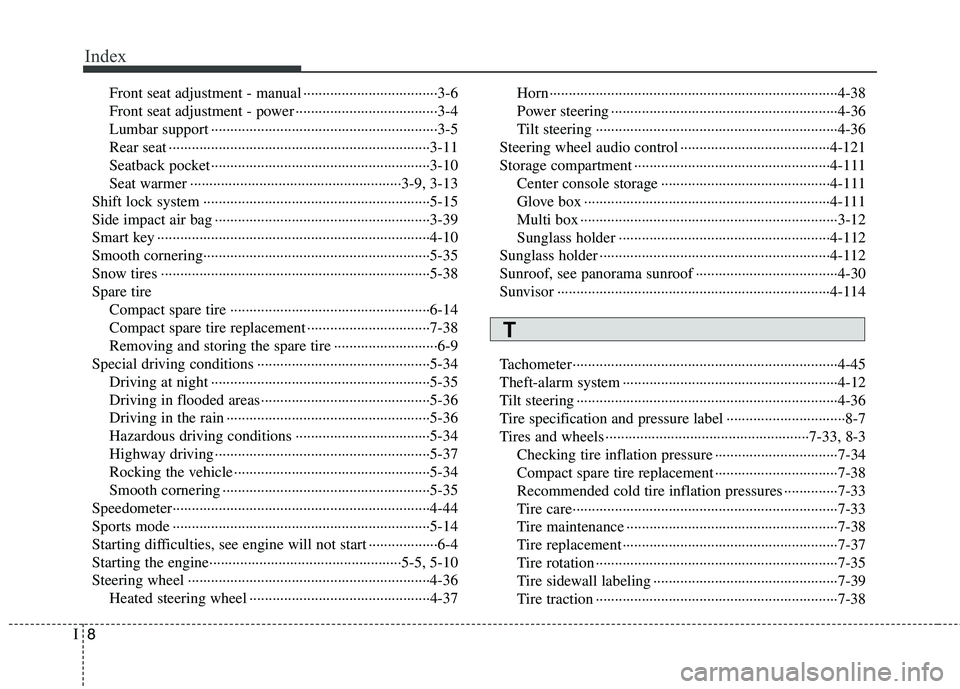
Index
8
I
Front seat adjustment - manual ···································3-6
Front seat adjustment - power ·····································3-4
Lumbar support ···························································3-5
Rear seat ····································································3-11
Seatback pocket ·························································3-10
Seat warmer ·······················································3-9, 3-13
Shift lock system ···························································5-15
Side impact air bag ························································3-39
Smart key ·······································································4-10
Smooth cornering···························································5-35
Snow tires ······································································5-38Spare tire
Compact spare tire ····················································6-14
Compact spare tire replacement ································7-38
Removing and storing the spare tire ···························6-9
Special driving conditions ·············································5-34 Driving at night ·························································5-35
Driving in flooded areas············································5-36
Driving in the rain ·····················································5-36
Hazardous driving conditions ···································5-34
Highway driving ························································5-37
Rocking the vehicle ···················································5-34
Smooth cornering ······················································5-35
Speedometer···································································4-44
Sports mode ···································································5-14
Starting difficulties, see engine will not start ··················6-4
Starting the engine··················································5-5, 5-10
Steering wheel ·······························································4-36 Heated steering wheel ···············································4-37 Horn···········································································4-38
Power steering ···························································4-36
Tilt steering ·······························································4-36
Steering wheel audio control ·······································4-121
Storage compartment ···················································4-111 Center console storage ············································4-111
Glove box ································································4-111
Multi box ···································································3-12
Sunglass holder ·······················································4-112
Sunglass holder ····························································4-112
Sunroof, see panorama sunroof ·····································4-30
Sunvisor ·······································································4-114
Tachometer·····································································4-45
Theft-alarm system ························································4-12
Tilt steering ····································································4-36
Tire specification and pressure label ·······························8-7
Tires and wheels ·····················································7-33, 8-3 Checking tire inflation pressure ································7-34
Compact spare tire replacement ································7-38
Recommended cold tire inflation pressures ··············7-33
Tire care·····································································7-33
Tire maintenance ·······················································7-38
Tire replacement ························································7-37
Tire rotation ·······························································7-35
Tire sidewall labeling ················································7-39
Tire traction ·······························································7-38
T